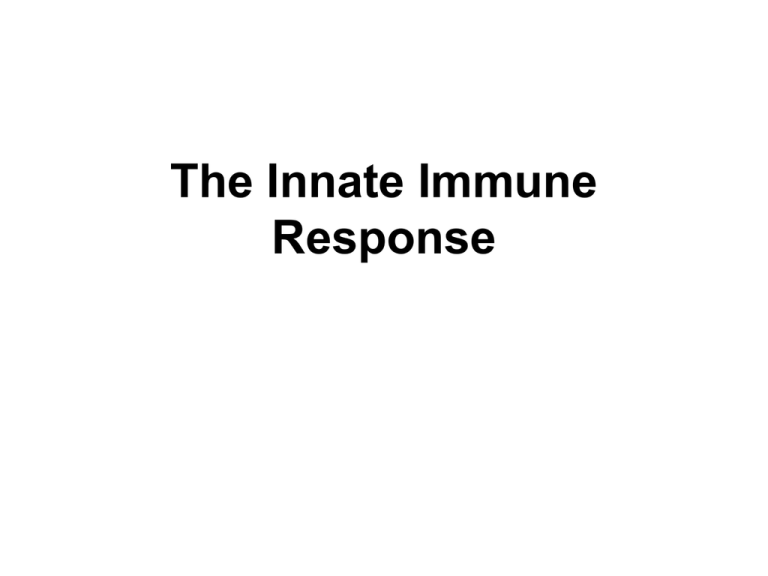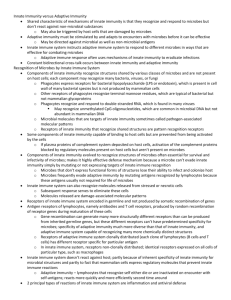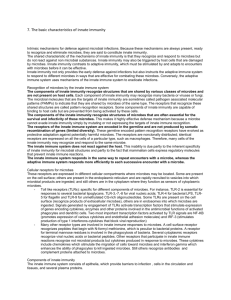
The Innate Immune
Response
FUNCTIONS OF THE IMMUNE SYSTEM:
• Recognize, destroy and clear a diversity of pathogens.
•
Initiate tissue and wound healing processes.
• Recognize and clear damaged self components.
Exhibit “tolerance” to innocuous material including self
The Normal Immune Response
The normal immune response is best understood in the
context of defense against infectious pathogens, the
classical definition of immunity.
Innate immunity refers to defense mechanisms that have
evolved to specifically recognize microbes and protect
individuals against infections.
Adaptive immunity consists of mechanisms that are
stimulated and are capable of recognizing microbial and
nonmicrobial substances.
Innate immunity
The first line of defense always ready to prevent
and eradicate infections.
Adaptive immunity
Develops later, after exposure to microbes, and
is even more powerful than innate immunity in
combating infections.
By convention, the term “immune response”
refers to adaptive immunity.
Innate and Adaptive immunity represent two different arms of the
immune system that work together in host defense.
Innate Immunity (natural/native):
• Provides immediate protection from infection.
• Is broadly specific to microbes and tissue damage products.
• Does not change in response to reinfection (nonadaptive)
• Initiates processes that lead to activation of adaptive immune
responses.
Adaptive Immunity (specific/acquired):
• Appears to adapt to a variety of non-self components (acquired)
• Is highly specific to a particular molecule “antigen”
• Responses upon reinfection are faster, better and stronger
(memory)
• Generates proteins and cells that enhance innate immune function.
http://classconnection.s3.amazonaws.com/536/flashcards/1317536/jpg/paneth_cell1332475911026.jpg
INNATE IMMUNITY
A major components of innate immunity are epithelial
barriers that block entry of microbes.
Epithelia of the skin and gastrointestinal and respiratory
tracts provide mechanical barriers to the entry of
microbes from the external environment.
Epithelial cells also produce anti-microbial molecules
such as defensins, and lymphocytes located in the
epithelia combat microbes at these sites.
If microbes do breach epithelial boundaries, other
defense mechanisms are called in.
Skin
http://www.bbcm.univ.trieste.it/~antimic/images/ampmech.jpg
http://ars.els-cdn.com/content/image/1-s2.0S0091674912035634-gr1.jpg
http://4.bp.blogspot.com/IlBLt5vn9Js/UKEWss4UTMI/AAAAAAAAByU/tSRUZjiBwxc/s1600/SKIN+LAYERS.jpg
Lung
http://cmr.asm.org/content/24/1/210/F1.large.jpg
Gut
Defensins are antimicrobial peptides
http://www.nature.com/nri/journal/v9/n11/images/nri2655-f3.jpg
The two most important cellular reactions of innate
immunity
Inflammation, the process in which phagocytic leukocytes are
recruited and activated to kill microbes.
Anti-viral defense, mediated by dendritic cells and NK cells.
http://www.inflammationreliefguide.com/wp-content/uploads/2011/10/Inflammatory-Response.jpg
http://dermatology-s10.cdlib.org/142/case_presentations/candidaglabrata/1.jpg
http://textbookofbacteriology.net/cellsindefenses75.jpg
Innate vs Adaptive Immune Components
There are also humoral vs cellular immune components
Red blood cell count
Male: 4.32-5.72 trillion cells/L*
(4.32-5.72 million cells/mcL**)
Female: 3.90-5.03 trillion cells/L
(3.90-5.03 million cells/mcL)
Hemoglobin
Male: 13.5-17.5 grams/dL***
(135-175 grams/L)
Female: 12.0-15.5 grams/dL
(120-155 grams/L)
Hematocrit
Male: 38.8-50.0 percent
Female: 34.9-44.5 percent
White blood cell count
3.5-10.5 billion cells/L
(3,500 to 10,500 cells/mcL)
Platelet count
150-450 billion/L
(150,000 to 450,000/mmol****)
http://www.mayoclinic.com/health/complete-blood-count/MY00476/DSECTION=results
•Granulocytes (or polymorphonuclears)
• Neutrophils (or segs): 50 - 70% relative value (2500-7000
absolute value)
• Eosinophils: 1 - 3% relative value (100-300 absolute value)
• Basophils: 0.4% - 1% relative value (40-100 absolute
value)
•Agranulocytes (or mononuclears)
• Lymphocytes: 25 - 35% relative value (1700-3500 absolute
value)
• Moncytes: 4 - 6% relative value (200-600 absolute value)
Each differential always adds up to 100%.
To make an accurate assessment, consider both relative and
absolute values. For example a relative value of 70% neutrophils
may seem within normal limits; however, if the total WBC is 20,000,
the absolute value (70% x 20,000) would be an abnormally high
count of 14,000.
http://www.rnceus.com/cbc/cbcwbc.html
Leukocytes and epithelial cells that participate in innate
immunity are capable of recognizing components of
microbes that are shared among related microbes and
are often essential for the infectivity of these pathogens.
Recognition of PAMPs from different classes of microbial
pathogens. Viruses, bacteria, fungi, and protozoa display
several different PAMPs, some of which are shared
between different classes of pathogens. Major PAMPs are
nucleic acids, including DNA, dsRNA, ssRNA, and 5′triphosphate RNA, as well as surface glycoproteins (GP),
lipoproteins (LP), and membrane components
(peptidoglycans [PG], lipoteichoic acid [LTA], LPS, and GPI
anchors). These PAMPs are recognized by different
families of PRRs.
Recognition of PAMPs from different classes of microbial pathogens.
Mogensen T H Clin. Microbiol. Rev. 2009;22:240-273
http://www.pasteur.fr/ip/portal/action/WebdriveActionEvent/oid/01s-00003p-00i
How are Things Recognized
These microbial structures are called pathogen
associated molecular patterns (PAMPs).
Leukocytes also recognize molecules released by injured
and necrotic cells, which are sometimes called dangerassociated molecular patterns (DAMPs).
The cellular receptors that recognize these molecules are
often called pattern recognition receptors.
The best-defined pattern recognition receptors are a
family of proteins called Toll-like receptors (TLRs) that are
homologous to the Drosophila protein Toll.
http://www.invitrogen.com/etc/medialib/en/images/ics_organized/applications/cell_tissue_anal
ysis/data_diagram/750_wide.Par.59118.Image.750.810.1.gif
http://ars.els-cdn.com/content/image/1-s2.0-S0091674909016364-gr2.jpg
TLRs are specific for components of different bacteria and viruses. TLRs
are located on the cell surface and in endosomes, so they are able to
recognize and initiate cellular responses to extracellular and ingested
microbes.
Upon recognition of microbes, the TLRs and other sensors signal by a
common pathway that leads to the activation of transcription factors,
notably NF-κB (nuclear factor κB). NF-κB turns on the production of
cytokines and proteins that stimulate the microbicidal activities of various
cells, notably the phagocytes.
Other cellular receptors bind microbes for phagocytosis; these include
receptors for mannose residues, which are typical of microbial but not host
glycoproteins, and receptors for opsonins such as antibodies and
complement proteins that coat microbes.
Macrophages
Macrophages are a part of the mononuclear phagocyte system.
Macrophages that have phagocytized microbes and protein antigens
process the antigens and present peptide fragments to T cells. Thus,
macrophages function as APCs in T-cell activation.
Macrophages are key effector cells in certain forms of cell-mediated
immunity, the reaction that serves to eliminate intracellular microbes. In
this type of response, T cells activate macrophages and enhance their
ability to kill ingested microbes.
Macrophages also participate in the effector phase of humoral immunity.
Macrophages efficiently phagocytose and destroy microbes that are
opsonized (coated) by IgG or C3b.
http://www.humpath.com/IMG/jpg/alveolar_macrophages_01_1-2.jpg
Monocytes and neutrophils are phagocytes in the blood that can
rapidly be recruited to any site of infection; monocytes that enter the
tissues and mature are called macrophages .
http://php.med.unsw.edu.au/cellbiology/images/a/a8/Endocytosis_types.png
http://iai.asm.org/content/80/4/1304/F1.large.jpg
http://dc352.4shared.com/doc/-4JNWl_7/preview_html_m6a877314.jpg
http://classroom.sdmesa.edu/eschmid/f31-16_phagocytosis.jpg
http://www.nature.com/nrmicro/journal/v7/n5/images/nrmicro2128-f2.jpg
Neutrophils are the first responders of the body's defense system.
Neutrophils rapidly localize to areas of acute infection and
phagocytize bacteria. Their cytoplasmic granules contain proteases
and they are capable of generating reactive oxygen intermediates to
kill the invading organism.
Neutrophils are the most abundant white blood cell in circulation but
they have a half life of only 1-2 days.
http://upload.wikimedia.org/wikipedia/commons/2/29/Segmented_neutrophils.jpg
http://www.nature.com/labinvest/journal/v80/n5/images/3780067f3.jpg
http://medcell.med.yale.edu/histology/blood_bone_marrow_lab/images/neutrophi
l_em.jpg
http://c431376.r76.cf2.rackcdn.com/38337/fimmu-03-00365-HTML/image_m/fimmu-03-00365-g001.jpg
http://www.rbej.com/content/figures/1477-7827-1-116-3.jpg
http://edoc.hu-berlin.de/dissertationen/averhoff-petra-2006-05-24/HTML/image002.gif
http://www.elsevierimages.com/images/vpv/000/000/033/33679-0550x0475.jpg
http://www.bio.davidson.edu/courses/immunology/students/spring2006/finley/Imm%202-19.jpg
The proteins of the complement system, are some of the most
important plasma proteins of the innate immune system.
In innate immunity the complement system is activated by microbes
using the alternative and lectin pathways; in adaptive immunity it is
activated by antibodies using the classical pathway.
http://www.profelis.org/amc/vorlesungen/gifs/MMPE_13IMM_163_02_eps.gif
http://ars.els-cdn.com/content/image/1-s2.0-S0145305X11000632-gr1.jpg
Natural Killer Cells
NK cells are endowed with the ability to kill a variety of infected and
tumor cells, without prior exposure to or activation by these microbes or
tumors.
This ability makes NK cells an early line of defense against viral
infections and, perhaps, some tumors.
CD16 is an Fc receptor for IgG, and it confers on NK cells the ability to
lyse IgG-coated target cells. This phenomenon is known as antibodydependent cell-mediated cytotoxicity (ADCC).
http://weloveteaching.com/0bio105/lectures/systems/NK.gif
The functional activity of NK cells is
regulated by a balance between signals
from activating and inhibitory receptors[10].
There are many types of activating
receptors, of which the NKG2D family is
the best characterized. The NKG2D
receptors recognize surface molecules that
are induced by various kinds of stress,
such as infection and DNA damage. NK
cell inhibitory receptors recognize self–
class I MHC molecules, which are
expressed on all healthy cells.
The inhibitory receptors prevent NK cells
from killing normal cells.
Virus infection or neoplastic transformation
often induces expression of ligands for
activating receptors and at the same time
reduces the expression of class I MHC
molecules.
As a result the balance is tilted toward
activation, and the infected or tumor cell is
killed
http://ars.els-cdn.com/content/image/1-s2.0-S0264410X12000308-gr4.jpg
http://www.nature.com/nri/journal/v2/n10/images/nri911-f1.gif
Major Histocompatibility Complex (MHC) Molecules: Peptide
Display System of Adaptive Immunity
.
MHC molecules were discovered as products of genes that evoke
rejection of transplanted organs, and their name derives from the
recognition that they are responsible for tissue compatibility between
individuals.
The physiologic function of MHC molecules is to display peptide
fragments of proteins for recognition by antigen-specific T cells.
In humans the genes encoding the major histocompatibility molecules
are clustered on a small segment of chromosome 6, the major
histocompatibility complex, or the human leukocyte antigen (HLA)
complex, so named because in humans MHC-encoded proteins were
initially detected on leukocytes by the binding of antibodies. The HLA
system is highly polymorphic, meaning that there are many alleles of
each MHC gene in the population and each individual inherits one set
of these alleles that is different from the alleles in most other
individuals. This, as we see subsequently, constitutes a formidable
barrier in organ transplantation.
The virus-encoded proteins m04, m06 and m152 inhibit MHC class I expression on the surface of mouse cytomegalovirus (MCMV)infected cells by a complex process that differs depending on the MHC class I alleles present in the host22. m04 can be expressed on the cell
surface of MCMV-infected cells in a complex with MHC class I molecules; however, how this influences the recognition of MHC class I
molecules by receptors on natural killer (NK) cells or T cells is unknown. Human cytomegalovirus (HCMV) also blocks the expression of
MHC class I molecules in infected cells in an allele-specific manner (reviewed in Ref. 65). The HCMV proteins US2, US3, US10 and US11
interact with the MHC class I heavy chains on their own or with the heavy chains complexed with 2-microglobulin, ultimately resulting in
their degradation, whereas US6 blocks TAP (transporter associated with antigen processing) function and UL83 inhibits protein entry into
the proteasome. UL40 provides a leader peptide that binds to HLA-E allowing its expression on the surface of HCMV-infected cells,
presumably for interactions with the inhibitory CD94–NKG2A (NK group 2, member A) receptor on NK cells. Both MCMV and HCMV
inhibit expression of the NKG2D ligands in infected cells. The MCMV-encoded m152 protein targets RAE1 (retinoic acid early transcript
1), as well as MHC class I molecules, for degradation; m145 and m138 cooperate to prevent MULT1 (murine UL16-binding protein
(ULBP)-like transcript 1) expression; and m138 and m155 cause degradation of H60. In humans, the HCMV-encoded UL16 protein inhibits
expression of MICB (MHC-class-I-polypeptide-related sequence B), ULBP1, ULBP2 and RAET1G (retinoic-acid early transcript 1G),
whereas UL142 prevents expression of MICA. Certain alleles of MICA, such as the common allele MICA*008, are resistant to
downregulation by HMCV because of a truncation of the cytoplasmic domain. CD155, a ligand for the activating NK-cell receptors
DNAM1 (DNAX adhesion molecule 1) and CD96, is targeted by UL141.
http://www.nature.com/nri/journal/v8/n4/fig_tab/nri2276_F2.html
The innate immune system provides immediate protection.
The adaptive response takes time to develop and is antigen specific.
Activation of B and T lymphocytes
Naive
Naive
Plasma cells








